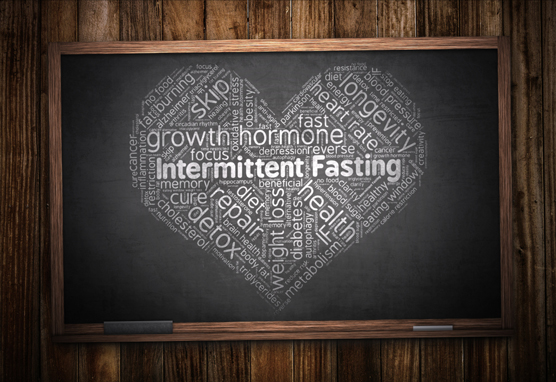Intermittent fasting is a hot topic in the research world. Here I get you up to speed on what the scientists presently know.
 © Creatus / Shutterstock.com
© Creatus / Shutterstock.comHow intermittent fasting affects your cells and hormones
The shear act of restricting food and calories for an extended period of time sets off a host of bodily processes on the cellular and molecular level. During the fasting state, the following actions occur.Cells
Genes are activated that direct cells to preserve resources. Rather than grow and divide, cells in the fasting mode are stalled. In this state, they’re mostly resistant to disease and stress. The changes in the function of these genes promote longevity.Cells enter into autophagy, a kind of cellular housekeeping sparking cellular rejuvenation. Autophagy is that self-cleaning cellular process that boosts brain functioning and maybe even longevity. When cells are in fasting mode and don’t have to work to break down food, they pause their usual tasks and stop dividing. Instead, they work on repairing and recycling damaged components and digest dead or toxic cell matter.
Cells activate pathways that enhance their defenses against oxidative and metabolic stress. Oxidative stress is one of the major contributing factors for aging and the development of many chronic diseases. Oxidative stress involves unstable molecules called free radicals, which react with other important molecules (like protein and DNA) and injure them. Fighting off free radicals also leads to reduced inflammation — a major cause of many diseases.
Your entire body minimizes the building processes (such as making new cells), instead, favoring cellular repair systems. This transition is what improves health and disease resistance. After you begin to eat again, your cells have adapted to make better use of the fat, carbs, and proteins you ingest.
Hormones
Intermittent fasting decreases some hormones and increases others. Intermittent fasting decreases the production of the following:- Insulin: Intermittent fasting keeps insulin levels low for most of the day, because insulin is released when you eat. Many prediabetics have a condition known as insulin resistance, meaning their insulin isn’t effective in facilitating blood sugar entering the cells. Intermittent fasting improves the actions of insulin, making cells more sensitive to the hormone. An increase in insulin sensitivity causes insulin and blood sugar levels to drop dramatically. Lower insulin levels make stored body fat more accessible. Lower insulin levels help drive weight loss.
- IGF-1: This hormone is key to cellular growth. IGF-1 increases cancer risk and accelerates aging when not suppressed. High levels of IGF-1, which is a protein produced by the liver, specifically raise the risks of colorectal, breast, and prostate cancer. Low levels of IGF-1 reduce those risks.
- Glucagon: Glucagon is a hormone produced by the pancreas with opposite effects to its pancreatic twin, insulin. Glucagon raises metabolic rate, decreases appetite, and increases the breakdown of body fat for use as energy.
- Human growth hormone (HGH): HGH, produced by your pituitary gland, plays a key role in growth, body composition, cell repair, and metabolism, boosting muscle growth, strength, and exercise performance, while helping you recover from injury and disease. Insulin spikes (with regular eating patterns) can disrupt your natural human growth hormone production.
- Norepinephrine: Also called noradrenaline, your adrenal glands and nerves release this hormone that functions both as a hormone and neurotransmitter (a substance that sends signals between nerve cells). The general role of norepinephrine is to mobilize the brain and body for action. Intermittent fasting not only boosts the production but also the release of this fat-burning hormone. Norepinephrine is the main driver of the increased metabolic rate observed with intermittent fasting.
Weight loss occurs when you create a calorie deficit. The alteration in hormones will increase your metabolic rate. In other words, intermittent fasting works on both sides of the calorie equation. It boosts your metabolic rate (increases calories out) and reduces the amount of food you eat (reduces calories in) — a double weight-loss whammy! Reduced insulin levels, higher HGH levels, and an increased amount of circulating norepinephrine all increase the breakdown of body fat and facilitate its use for energy.
Flipping your metabolic switch
Metabolic switching is the term used to describe the point during fasting when cells have used up their stores of rapidly accessible, sugar-based fuel, and begin converting fat into energy in a slower metabolic process. Metabolic switching triggers the age-old adaptation to periods of food scarcity during the days of the hunter-gatherers. No food for days on end meant the body had to adapt to utilizing fat stores for energy in lieu of carbohydrates. Furthermore, the fasted state led to improved brain function, enabling humans to devise creative ways to overcome the physical and mental challenges of stalking prey.The beauty of intermittent fasting is its ability to prompt your body to metabolically switch it up, meaning burn up fat stores for energy. This is a time-limited period of ketosis, meaning when your body goes from using glucose (blood sugar) as a fuel source to tapping into fat stores and creating ketones from the fat (a chemical derived from fat) for energy. You may recognize the word ketones from the popular Keto Diet.
During a period of fasting, the decreasing insulin levels cause cells to release their glucose stores as energy. After about ten hours of no food, your stores of glucose are depleted. With its tanks of glucose empty, the body resorts to dipping into the endless amount of stored fat (in fat cells) as an energy source. Fat cells break down the fat and release it into the bloodstream where it travels to the liver to be converted into more usable energy in the form of ketones. Ketones then circulate throughout the body and are the major source of energy for your cells during the fasted state.
To ensure that you’re flipping your metabolic switch during your intermittent fast, do not eat or drink any calorie containing food during your fasting windows.

